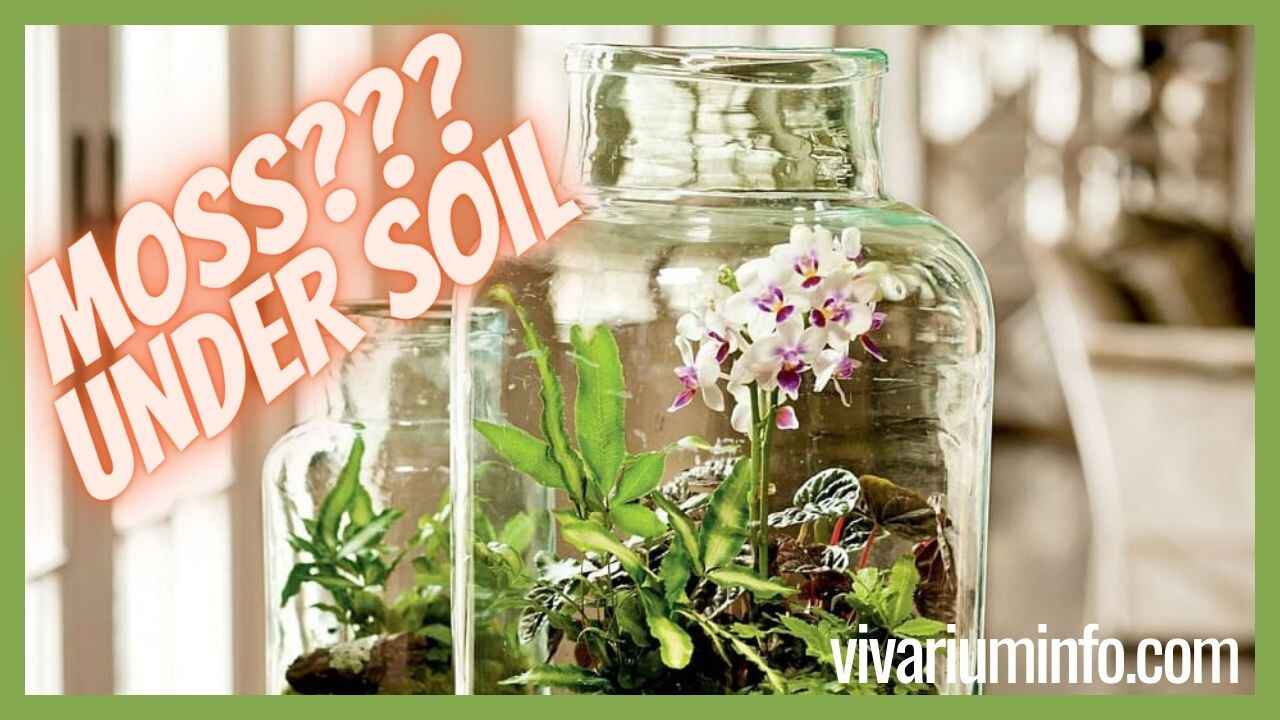Placing moss underneath the soil in a terrarium is a common practice that offers several benefits for the overall health and aesthetics of the miniature ecosystem. While moss is often used as a decorative element on top of the soil, it can also serve an important functional purpose when placed beneath the soil layer. Here’s why adding moss under the soil is a smart move for your terrarium setup:
1. Acts as a Natural Barrier for Drainage
One of the primary reasons to place moss under the soil is its ability to act as a natural barrier, especially in the drainage layer.
- How it works: When placed between the soil and the drainage layer (such as pebbles or gravel), moss helps keep the soil from mixing with the drainage layer below it. This prevents the soil from clogging up the drainage layer, ensuring that excess water can still flow freely down into the bottom of the terrarium.
- Benefit: By allowing proper drainage and water flow, the moss helps avoid waterlogging at the base of the terrarium, which can lead to root rot and other plant health issues.
2. Helps Retain Moisture
Moss has excellent moisture-retaining properties, which can be beneficial for the plants in your terrarium, especially those that thrive in high humidity.
- How it works: When placed beneath the soil, moss can help regulate moisture levels. It absorbs excess water from the soil, storing it in its fibers, and then slowly releases it back into the soil as needed. This helps maintain consistent moisture levels and prevents the soil from drying out too quickly.
- Benefit: This creates a more stable environment for plants, particularly moisture-loving varieties like ferns, mosses, and tropical plants. It helps prevent the soil from becoming too dry or too wet, both of which can stress your plants.
3. Improves Aeration and Root Health
Moss adds a layer of natural structure to the soil, allowing for better airflow and root development.
- How it works: The porous nature of moss creates small pockets of air between the soil particles, which improves aeration at the root level. Well-aerated soil is essential for healthy root growth, as it allows oxygen to reach the roots and prevents the soil from becoming compacted.
- Benefit: Healthy, oxygen-rich soil encourages roots to spread and grow more vigorously, which is crucial for the overall health of your plants.
4. Prevents Soil Erosion
Moss can help stabilize the soil by preventing it from eroding, particularly in small or compact terrariums.
- How it works: Moss creates a sort of “blanket” over the soil, binding it together and reducing the chances of soil shifting or washing away when watered. This is especially useful in closed terrariums where water evaporation is higher, and frequent misting can cause the soil to become loose.
- Benefit: This helps maintain the structural integrity of your terrarium, ensuring that the soil stays in place and doesn’t wash away into the drainage layer, where it could cause blockages or mess up your aesthetic.
5. Enhances Aesthetics
Moss can be used for visual appeal, providing a soft, natural-looking base beneath the soil, which can improve the overall aesthetic of the terrarium.
- How it works: While it primarily serves a functional role, moss can also create a more cohesive and lush look when used under the soil. It can give the terrarium a more rustic, forest-like feel, as moss is often found naturally growing on the forest floor beneath the leaf litter and soil.
- Benefit: The subtle green color of the moss can complement the plants above, adding texture and depth to the landscape. It also contributes to a more natural, organic environment.
6. Helps Control Fungal Growth
In some cases, placing moss under the soil can help deter the growth of certain harmful fungi.
- How it works: Moss can act as a barrier to mold or fungus growth by absorbing moisture from the soil before it becomes stagnant and causes issues. Its natural properties help maintain the right level of humidity, which can prevent the development of harmful fungi.
- Benefit: This ensures that your plants remain healthy and free from diseases that could negatively affect the terrarium’s ecosystem.
How to Use Moss Under the Soil in a Terrarium
If you’re interested in adding moss beneath the soil in your terrarium, here’s a quick guide on how to do it:
- Prepare the Base: Start by adding a layer of small pebbles or gravel at the bottom of your terrarium for drainage.
- Place Mesh or Fabric: If you’re using a fine potting mix, lay a thin sheet of mesh or fabric over the drainage layer to keep the soil from mixing with the pebbles.
- Add Moss: Lay a thin layer of moss over the mesh or directly on top of the drainage layer if no mesh is needed. Gently press it down to ensure it’s even and compact.
- Add Soil: Now, carefully add your soil mixture on top of the moss layer. Be sure to level the soil, leaving enough space for your plants.
- Plant Your Terrarium: Once the soil is in place, you can go ahead and plant your terrarium, adding your plants according to your design.
Final Thoughts
Adding moss underneath the soil in your terrarium is a simple yet effective way to improve drainage, retain moisture, and promote healthy plant growth. It’s a functional and aesthetic solution that creates a balanced and thriving environment for your plants. Whether you’re building a low-maintenance succulent terrarium or a lush tropical biome, the benefits of moss are clear—it’s nature’s little helper for your indoor garden.
